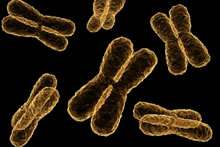New genetic risk factor found for schizophrenia

Researchers at Emory's Rollins School of Public Health have identified a large duplication on chromosome 7q11.23 as a new risk factor for schizophrenia. (7q11.23 refers to the specific location of the duplicated region on the chromosome.)
Human DNA is organized into structures called chromosomes that are identified by a number or letter (1-22, X and Y), and each chromosome has two arms that are identified as "q" and "p." Specific regions on each arm are also mapped by numbers. In the 7q11.23 region, the vast majority of individuals have two copies. Three copies in this region, however, are known indicators of autism and intellectual disability. Findings from this study have now associated three copies of the 7q11.23 region with schizophrenia.
According to lead researcher Jennifer Mulle, PhD, assistant professor in the Department of Epidemiology at Rollins School of Public Health at Emory, "Duplication at this region on chromosome 7 increases the risk of schizophrenia by about 10-fold. We also found it interesting that three different disorders (schizophrenia, autism, and intellectual development) that strike at different times and present in different ways, have genetic links to this same region. Our findings support the notion of a neurodevelopmental link between these disorders."
The complete study is available online, as "articles in press" from the journal Biological Psychiatry.
When researchers assessed a small sample population of 554 schizophrenia cases and 1,014 non-schizophrenia cases they found a large duplication on chromosome 7q11.23 in two unrelated patients. They then incorporated genome-wide data from seven additional studies into an analysis totaling 14,387 schizophrenia cases and 28,139 non-schizophrenia cases. Results indicated duplications in 11 of the schizophrenia cases compared to only one duplication in the non-schizophrenia cases. The duplicated region is large and contains more than 25 genes.
"Our research was comprised of data from multiple groups, representing more than eight countries around the world," says Mulle. "These findings indicate a new risk factor for schizophrenia and suggest that individuals with the 7q11.23 duplication are at future risk for psychosis."















